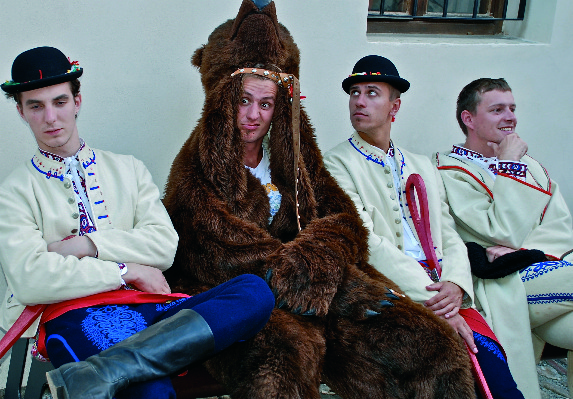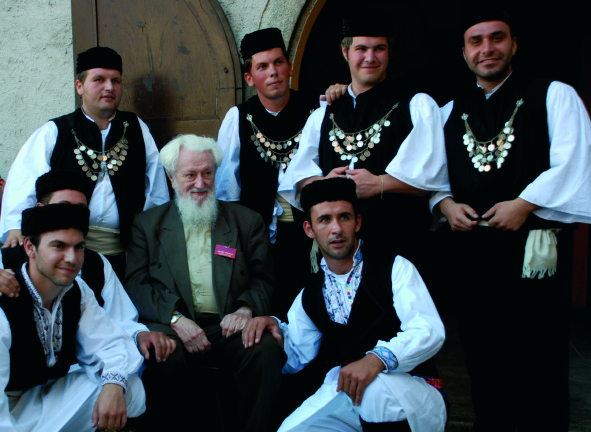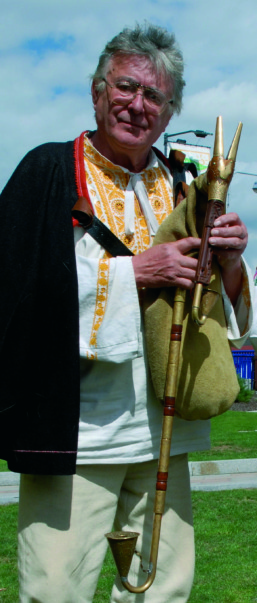The Bagpipe Society
Strakonice, where the Pipes Play
Despite centuries of proliferation and cultural adaptation, Europe’s bagpiping traditions have seldom been appreciated collectively as a pan- European cultural asset. Nor are they widely seen, and usually only in isolation.
I blame the Renaissance.
That was when aristocratic patronage began installing a “classical” musical style based on costly, pitch-perfect, fragile and non-portable instruments, courtly ensembles and salon aesthetics. Composed scores and musical theory ousted oral tradition. Drones were dropped and music became a showcase of prosperity. The popular traditions of older times were pushed aside as naïve rusticism and bumpkin “folk” ways.
These days — after centuries of upheaval, migration and war — old oral remnants are hard to find. So, to enter the gates of the 13th century Bavor Castle in Strakonice, Southern Bohemia, during the biennial International Bagpipe Festival is to experience a rare immersion in music and dance that express deeper European identities and aesthetics.
This year’s Festival will be celebrated 25-28 August. It is not re- enactment. It is not historical. It is not a “medieval fayre”. It is a pageant of traditions and identity among mostly ordinary people, mostly in Central-Eastern Europe. What you’ll see on the stages and squares is practised performance art, often carrying remnant shadows of Soviet-era cultural programs that favoured large ensembles, for example, and, at the same time, threads of anti-Soviet cultural resistance. It overlays history’s scars with the expressions of human resilience that music and dance release.

So, I met a Hungarian bagpiper there who was a successful businessman who jetted around Europe. He was in the immaculate costume of a pig-herder. But his music countered any suggestion of “faux”. In 2010, I met Dr Bruno Ravnikar, professor of physical acoustics at the University of Ljubljana. For more than 50 years he had been actively advocating for his nation’s traditional performance arts. He was researching the lost piping tradition of southeastern Slovenia’s Bela Krajina region and had with him two very simple prototype instruments: a first step towards promoting a revival of the Slovenian bagpipe. He had recruited two friends to accompany him: “They are the only pipers we have in Slovenia,” said Bruno Ravnikar. And they’d had only a few weeks to prepare for their first public performance.
I met local housewives who get together once a week in their own communities to dance unselfconsciously, “just for fun”. Many took their children with them. I met instrument makers: the creators of traditional bagpipes who, in addition to their musicality, displayed breathtaking artistry and craftsmanship. I met pipers who were proud exemplars of their own traditions, and others who were curious about the traditions of others.
The old contexts of it all are long gone, of course. You’ll see wedding dances; no-one’s getting married. You will hear mourning; no-one’s died. You will listen to work songs; no-one, apart from the festival organisers, is doing any work… and the laundered, pressed and colourful traditional costumes are an origins-clouding spectacle in themselves.
It is all splendid. It is wonderful. And the local Dudák brewery is there, pouring affordable pints of their Nektar lager. There’s a bar, smoking grills dispense cheap but tasty, satisfying snacks and there are tables and nooks where you can sit and talk.

English isn’t necessarily the language of choice but the Festival provides performers with volunteer translators — holidaying school teachers for the most part — and I’ve invariably found that curiosity, respect and patience, along with a notebook and ballpoint, cross most language barriers. At Strakonice, you have a head-start: people, it seems, are warmly open and ready to be friendly.
I’ve had people ask me, “but is it authentic”? Sorry, but that’s a bit of a silly question — these people are doing what they do because it’s what they feel, and it comes from the heart. That’s the joy of Strakonice.
The town and the region have had bagpipes for centuries and bagpipers are embedded in the old, remembered folklore. The pipes played to dance to, to sing with, to express cultural identity and because it’s enjoyable.
The festival was launched to ensure the survival of things remembered by a dedicated Strakonice-born piper and folklorist, the late Josef Rezny. He co- founded and organized the old South Bohemian Festival of Songs and Dances in Strakonice, 1955-1961. The first bagpipes festival was held in 1967 to mark the town’s 600th anniversary but political blacklisting limited Josef Rezney’s involvement until 1989. As well as musicians and groups from around the Czech Republic, the festival typically draws exemplars of piping traditions from the Slovak Republic, France, Germany, Austria, Hungary, Italy, Spain, Turkey, Ireland, The Netherlands and Spain. And there are old friendships. Scotland’s Neilston and District Pipe Band has been a regular attender from the earliest days. The Galician Real Banda de Ourense also has a long relationship with the festival.

In 2004, Josef Rezny opened a conversation by telling me that there was “no such thing” as a ‘Czech’ bagpipe. He thought in cultural not political terms. So he spoke of a “middle European piping zone” within which regional traditions are variations on the wider theme. “The same kind of compound-reed instrument is played in all of these regions, in similar ensembles with instruments such as clarinets or fiddles, and similar styles of music are performed,” he said.
The piping traditions of Bavaria and other parts of Germany are closely associated with those in the Czech Republic, he continued. “Very similar bagpipes are played in Bohemia, Germany and Poland; and in Bohemia and Moravia, bellows-blown instruments are the norm. So there is no ‘Czech bagpipe’… this expression is nonsense. Every region of our country is different and they can still be distinguished by their dance and song repertoires. There is no ’national’ folklore.

“My own culture is that of the Prachen region. All my life, I have been collecting songs, dances and all of the related material I could concerning the piping tradition in my region. Our ensemble can dance many dances because I have been able to teach them. Our performances have to be adjusted for the festival stage, which is a certain kind of deformation, and everything would look and sound different in a village pub or at a village fair. Nevertheless, it is very good that, in every region, the ensembles have been trying to preserve the music, dance, costumes and customs.”
The Strakonice Bagpipe Festivals enable people to meet, honour one another and appreciate each others’ skills. Josef told me, “They can see what it looks and sounds like in another country. They can exchange knowledge and experience. But I do not have the feeling that the festival is the inspiration for the Prachen Ensemble of Folk Songs and Dances. There is no point, for example, in trying to play a traditional Prachen song on Bulgarian or French bagpipes. People can say we Bulgarian or French bagpipes. People can say we are very conservative but tradition means a close link with our own regional history, which has very deep roots in Europe.”
The Prachen tradition is strong within the greater region but, compared with piping traditions further west, such as those of Galicia, Brittany, Ireland and Scotland, it is still quite small. Josef Rezny estimated that it embraced some 300 pipers.
“In general, the culture is weakening, because the bearers of it have been dying out. It is very rare to find a family where the tradition is passed on from the older generation to the younger ones. It corresponds with general changes in today ́s society; what is ’normal’ and what is not? But in our country there is still something like a ‘hidden patriotism’ — a feeling of ethnic integrity — and that is why some features of the tradition can be preserved. The demand for teaching is steady, and teaching is available at the Strakonice Basic School of Music, and at similar schools of music in Pilsen, Domazlice, Liberec, Sedlčany… Prague. Besides that, a number of children and adult bagpipers learn through their folk ensembles, watching the more experienced pipers.” However, some of the pipers are self-taught and some have Josef Rezny’s tutor book — Skola hry na ceske dudy (School of playing the Czech bagpipes) — to help them.

According to Josef, “the most important thing is personal contact between a teacher and the learner. The teacher must be respected for his or her natural authority and personality so that the pupil asks for advice and appreciates being praised by the teacher. It is best for a learner to start three years in advance on the recorder to feel the music, and learn to read musical notation. If a child starts playing the recorder at the age of six, three years later he or she will be physically prepared to carry the instrument and, given some previous preparation, be ready to start playing the bagpipes.”
Josef Rezney saw needs for more high-quality instruments to meet a steady demand. “But there are only few instrument makers who can make really good instruments.” The usual woods used are plum — “very hard and also able to keep its inner consistency” — and pear, which is popular for its beautiful colour. Our best instrument maker is Pavel Cip from Zubri in Moravia.”
Some makers introduced tuning screws, next to each finger hole on the chanter. It is an innovation the Josef Rezny strongly disliked. “They say it is possible to fine tune every tone using the screws but I do not think so. The screw is made of metal, while the pipe is made of wood. Every movement of the screw does some damage to the pipe and, in time, the pipe has to be replaced. There is no other instrument of a similar kind having such nonsense like ’tuning screws” — why should the bagpipes have them?”

The standard tuning of Bohemian bagpipes is to E# major.
According to Josef, “Our bagpipes date back to the 13th century. Tuning has been determined by the need to play in ensemble with other instruments. At the beginning of the 19th century, the clarinet appeared and the bagpipes had no choice but to adjust to it. In our area, under the influence of the clarinet, the bagpipe had to be tuned in E#. If we want to play medieval music, we must have an instrument that can play in the key of that period: D- major or D-minor. So, in our ensemble, we have bagpipes with different tunings to suit the various needs of our repertoire — but all of the schools where they teach bagpipes use standard instruments tuned in E# major.”
The pipes’ repertoire derives from regional folklore traditions. And new music is composed in the folk ensembles, usually reflecting regional folklore. Bagpipes are an integral part of the greater region’s traditional musical culture. “Their influence can be seen in compositions by renowned composers, from the Baroque period up to the present,” said Josef Rezney. “There is a Baroque Pastorella in F, and a composition by Leopold Mozart (Amadeus Mozart ́s father) called Bauern Hochzeit (Peasant ́s Wedding) which is played on the hurdy-gurdy and bagpipes. Czech composers such as Smetana, Dvorak and others also used the bagpipes to express a pastoral motif. And at previous festivals, we have had contemporary composers performing their new music.”
Despite the pipes’ significance here, there is little commercial piping activity.
“There was a time when unemployed men took bagpipes and went begging, having been issued with an official licence to perform,” said Josef Rezny. “Typically, they knew only a little, almost nothing, but they were an attraction at village fairs. After the Second World War there were very few of them left. Nowadays pipers do not earn money like this. There are no busking zones in the Czech Republic, although on the Charles Bridge in Prague there is something like that. There, the competition is very strong and is almost impossible for a newcomer to play. In Linz or Nuremberg, there are streets where musicians are allowed to perform. The town is interested in it and the authorities give licenses to musicians, even foreign musicians, to play and accept money from the people. A few top ensembles get paid engagements and some pipers are able to earn session fees.
“But media interest in folk music has been declining,” said Josef Rezny. Josef Rezny died in Strakonice on 10 December, 2012.
The festival he founded lives on. And the invitation has been made.
Details are online at en.dudackyfestival.cz
- Data Processing Notice (GDPR)
-
@BagpipeSociety on X (formally known as Twitter)
-
TheBagpipeSociety on Instagram
-
 BagpipeSociety on Facebook
BagpipeSociety on Facebook
Something wrong or missing from this page? Let us know!
